Shrubs
“Pittosporum” has been added to your cart. View cart
Showing 17–32 of 35 results
-
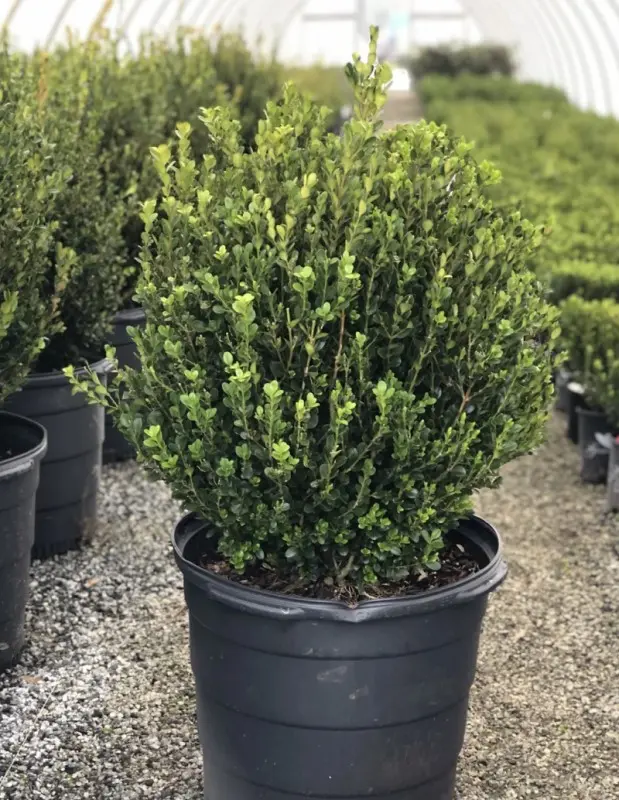
Japanese Boxwood
$0.00Add to LawnFull sunPartial sun3'-5'Deer resistantJapanese Boxwood (Buxus microphylla var. japonica) is a hardy, evergreen shrub known for its compact, rounded form and small, glossy green leaves. Native to Japan, this boxwood variety is a popular choice for low hedges, topiaries, and foundation plantings due to its ability to maintain a neat shape and dense foliage throughout the year. Unlike some other boxwoods, Japanese Boxwood is highly adaptable to warmer climates and is known for being resistant to boxwood blight, making it a favorite in various landscapes. Typically growing 3 to 5 feet in height and width, Japanese Boxwood has a naturally mounding form that can be easily pruned to suit a variety of shapes. It thrives in full sun to partial shade and is hardy in USDA zones 6-9. This shrub prefers well-draining soil and has moderate drought tolerance once established, though it benefits from regular watering in dry periods. Low-maintenance and versatile, Japanese Boxwood requires occasional trimming to maintain its shape, especially when used as a hedge or in formal garden designs. Its tolerance for pruning and slow growth rate make it ideal for creating clean lines and defined edges in garden borders. Japanese Boxwood’s evergreen foliage and adaptability to different garden styles make it a classic choice for adding structure and year-round greenery to landscapes. -
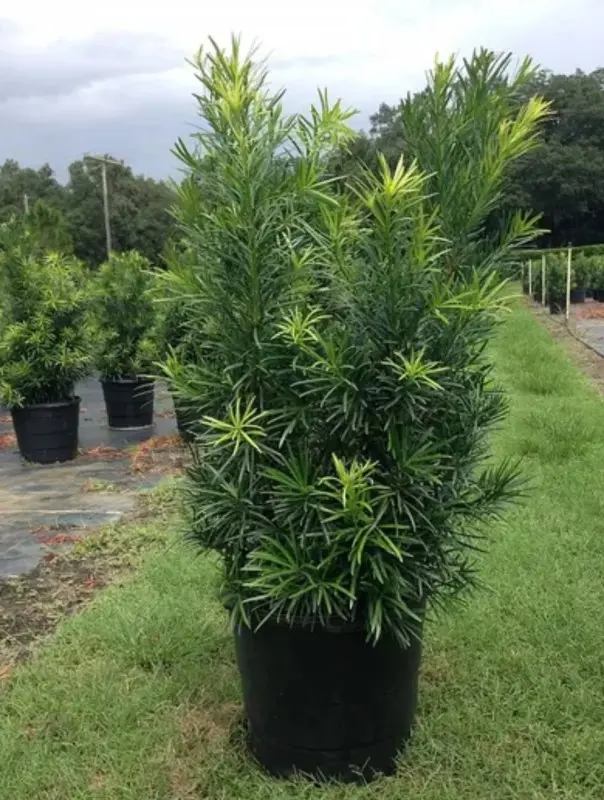
Japanese Yew
$0.00Add to LawnFull sunPartial sun6'-15'Deer resistantJapanese Yew (Taxus cuspidata) is a versatile evergreen shrub or small tree known for its dark green, needle-like foliage, dense form, and adaptability. Native to Japan, Korea, and parts of China, Japanese Yew is prized for its elegant appearance and ability to provide year-round color and structure to landscapes. Its soft, finely textured foliage creates a lush, green backdrop, and mature plants often develop attractive red berries (arils) in the fall on female plants, which add seasonal interest and attract birds. Japanese Yew can vary in size depending on the variety, with some types reaching heights of 10 to 40 feet, while dwarf cultivars stay more compact, around 3 to 5 feet. This plant thrives in USDA zones 4-7 and grows well in partial to full shade, though it can also handle full sun in cooler climates. Japanese Yew prefers well-draining soil and has moderate drought tolerance once established, making it well-suited for various landscape settings. Low-maintenance and slow-growing, Japanese Yew requires little pruning to maintain its shape, though it can be trimmed more frequently if used in formal hedges or topiaries. This hardy plant is resistant to deer and many common pests, which adds to its appeal as a reliable, long-lasting choice for borders, hedges, foundation plantings, or even as a standalone focal point. With its year-round foliage, graceful form, and adaptability, Japanese Yew is a classic addition to both traditional and contemporary garden designs. -

Kaleidoscope Abelia
$0.00Add to LawnFull sun-1'-3'Not deer resistantKaleidoscope Abelia (Abelia x grandiflora ‘Kaleidoscope’) is a stunning, evergreen shrub known for its vibrant, ever-changing foliage and compact growth habit. This variety of Abelia features variegated leaves that transition in color throughout the year, creating a "kaleidoscope" effect. In spring, the leaves emerge with a bright green center and golden-yellow edges. As the seasons progress, the yellow intensifies, and by fall, the foliage takes on rich shades of orange and red, adding warm hues to the landscape. Small, fragrant white or pale pink tubular flowers bloom from late spring through fall, attracting pollinators like bees and butterflies. Kaleidoscope Abelia typically grows 2 to 3 feet tall and 3 to 4 feet wide, forming a low, mounding shape that works well for borders, foundation plantings, or container gardens. It thrives in full sun to partial shade and is hardy in USDA zones 6-9. This shrub prefers well-draining soil and is relatively drought-tolerant once established, making it suitable for low-maintenance and water-wise landscapes. Requiring minimal care, Kaleidoscope Abelia benefits from light pruning in early spring to maintain its shape and promote fresh growth. Its resistance to pests and diseases, along with its year-round color, makes it a popular choice for adding long-lasting visual interest. With its changing foliage, fragrant blooms, and ease of care, Kaleidoscope Abelia is a versatile and colorful addition to both formal and informal garden designs. -
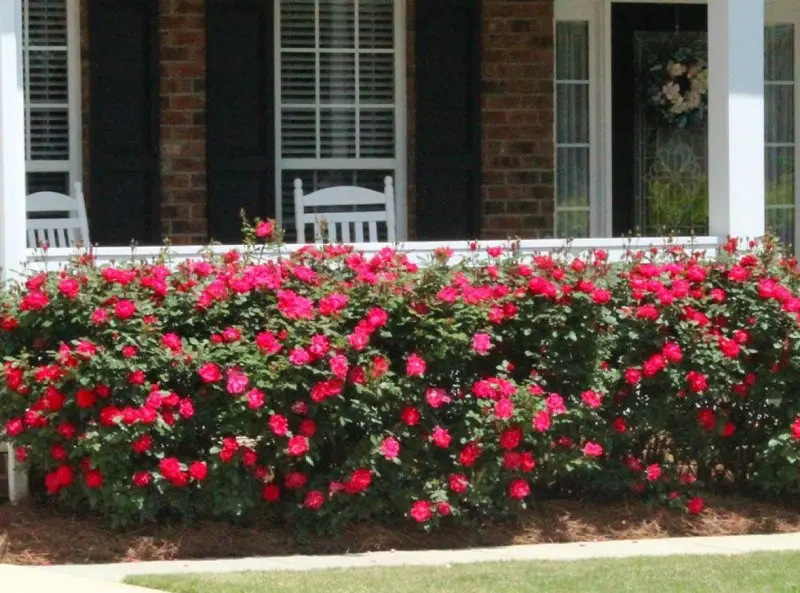
Knock Out Rose
$0.00Add to LawnFull sun-3'-5'Not deer resistantKnock Out Rose (Rosa 'Radrazz'), part of the popular Knock Out family of roses, is a versatile, low-maintenance shrub known for its prolific blooming and resistance to common rose diseases like black spot and powdery mildew. Introduced in 2000, Knock Out Roses have become a favorite in landscapes for their continuous blooms, which appear in bright shades of red, pink, yellow, and white. Blooming from spring until the first frost, they offer season-long color with minimal care. Knock Out Roses typically grow 3 to 4 feet in height and width, forming a dense, rounded shrub that works well in borders, mass plantings, and as a standalone accent. They thrive in full sun but can tolerate partial shade, and they are hardy in USDA zones 5-11. These roses prefer well-draining soil enriched with organic matter and benefit from regular watering, especially during dry spells, though they are somewhat drought-tolerant once established. Known for their easy care, Knock Out Roses require little more than annual pruning in late winter or early spring to maintain their shape and promote fresh growth. They are self-cleaning, meaning spent blooms naturally fall off, making deadheading unnecessary. With their vibrant blooms, disease resistance, and low-maintenance needs, Knock Out Roses are ideal for gardeners seeking beautiful, hassle-free roses that provide an abundance of color throughout the growing season. -
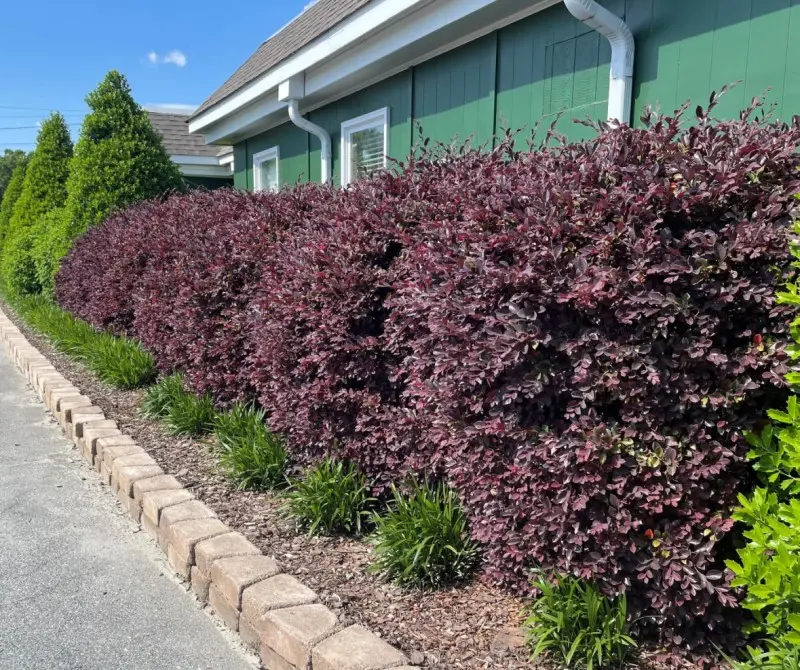
Loropetalum
$0.00Add to LawnFull sunPartial sun3'-8'Not deer resistantLoropetalum (Loropetalum chinense), also known as Chinese Fringe Flower, is a versatile, evergreen shrub known for its striking foliage and vibrant, fringe-like flowers. Native to Asia, Loropetalum is available in a variety of cultivars, with foliage colors ranging from deep green to burgundy and even dark purple, depending on the variety. In spring, it produces clusters of delicate, fringe-like flowers in shades of white, pink, or fuchsia, which contrast beautifully with the foliage and may reappear sporadically throughout the year. Loropetalum typically grows between 3 to 10 feet tall and wide, though certain varieties can be pruned to maintain a smaller, more compact shape or allowed to reach their full height as a small tree. It thrives in USDA zones 7-10, performing well in full sun to partial shade, with deeper foliage colors showing best in sunnier spots. This shrub prefers well-draining, slightly acidic soil and is moderately drought-tolerant once established, making it suitable for low-maintenance and water-wise gardens. Loropetalum requires minimal care beyond occasional pruning to maintain its shape, particularly if used as a hedge or border plant. Resistant to pests and diseases, it is a popular choice for both traditional and contemporary landscapes. Its year-round foliage, unique flower form, and array of colors make Loropetalum ideal for adding texture and vibrancy to garden borders, foundation plantings, privacy screens, or as a stunning standalone specimen. -
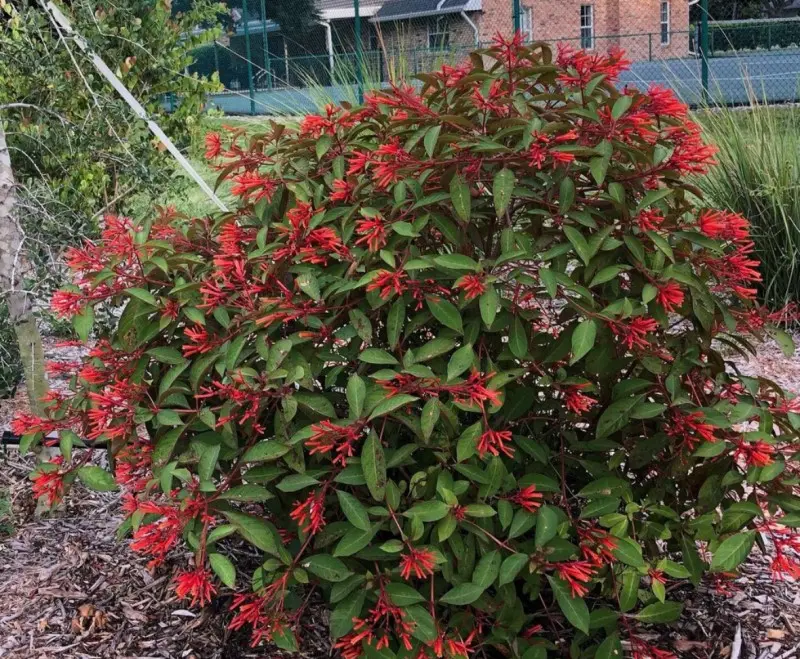
Mexican Fire Bush
$0.00Add to LawnFull sun-3'-5'Deer resistantMexican Fire Bush (Hamelia patens), also known as Firebush or Hummingbird Bush, is a tropical shrub known for its fiery red-orange tubular flowers and bright green foliage. Native to the Americas, including Mexico and Central America, this shrub blooms profusely from spring through fall, attracting hummingbirds, butterflies, and other pollinators with its vibrant flowers. The leaves of Mexican Fire Bush take on a reddish tint in cooler weather, adding to its seasonal color appeal. Mexican Fire Bush typically grows to 4 to 6 feet tall and wide, though it can reach up to 10 feet in warmer climates. It thrives in full sun and is hardy in USDA zones 8-11. While it prefers well-draining soil, it is adaptable to different soil types and is highly drought-tolerant once established. This shrub can handle high heat and humidity, making it an excellent choice for tropical or xeriscape gardens. Low-maintenance and pest-resistant, Mexican Fire Bush requires little care beyond occasional pruning to encourage bushier growth and to maintain shape. Its vibrant flowers and foliage make it ideal for borders, wildlife gardens, or as a striking standalone shrub. With its bold color, hardiness, and ability to attract pollinators, Mexican Fire Bush is a favorite for adding a touch of tropical warmth and wildlife interest to sunny landscapes. -

Nandina
$0.00Add to LawnFull sunFull shade3'-6'Deer resistantNandina (Nandina domestica), also known as Heavenly Bamboo, is a graceful, evergreen shrub prized for its colorful, finely textured foliage and seasonal interest. Despite the name, Nandina is not a true bamboo, though it has bamboo-like stems and a similar upright, clumping growth habit. Its delicate, compound leaves change colors throughout the year, transitioning from bright green in spring to shades of red, bronze, and burgundy in fall and winter. In summer, Nandina produces small white or pinkish flowers in airy clusters, followed by vibrant red berries in the fall that persist into winter, providing food for birds and adding additional color to the landscape. Nandina typically grows 4 to 8 feet tall with a spread of 2 to 4 feet, though there are dwarf varieties that stay more compact, making it suitable for a variety of landscape uses. It thrives in full sun to partial shade and is hardy in USDA zones 6-9. Adaptable and tolerant, Nandina can grow in various soil types as long as they are well-draining and can tolerate some drought once established. Low-maintenance and resilient, Nandina requires minimal pruning, though removing older stems at the base in early spring can help maintain a fuller, bushier appearance. Known for its pest and disease resistance, Nandina is commonly used in borders, foundation plantings, hedges, or as a focal point in garden beds. With its changing foliage colors, attractive berries, and year-round appeal, Nandina adds texture, color, and interest to gardens with minimal care requirements. -
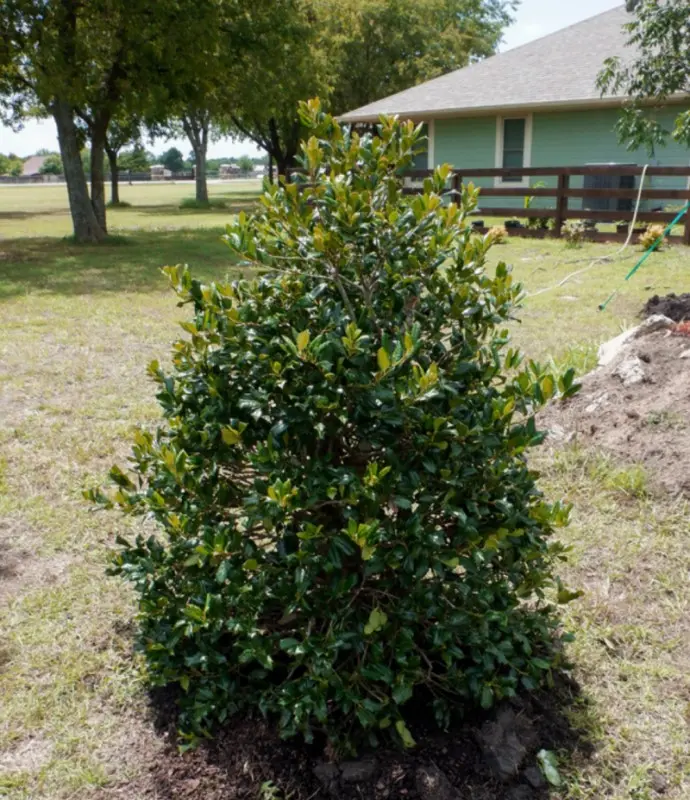
Nellie Stevens Holly
$0.00Add to LawnFull sunPartial sun6'-10'Not deer resistantNellie Stevens Holly (Ilex x 'Nellie R. Stevens') is a hardy, evergreen shrub known for its dense, pyramidal growth and classic holly look with dark green, glossy leaves. This popular hybrid is prized for its year-round foliage, low maintenance needs, and vibrant red berries that appear in winter, adding seasonal interest to landscapes and providing food for birds. The attractive foliage is complemented by small white flowers in the spring, which mature into the distinctive berries by late fall, given the presence of a nearby male holly (such as Ilex x 'Edward J. Stevens' or Ilex x 'Blue Prince'). Nellie Stevens Holly can grow to impressive heights of 15 to 25 feet with a spread of 8 to 12 feet, making it an excellent choice for hedging, privacy screens, or as a standalone focal point. It thrives in USDA zones 6-9, preferring full sun to partial shade, and is adaptable to a variety of soil types as long as they are well-draining. Known for its resilience, this holly variety is tolerant of drought, heat, and even urban pollution once established. Low-maintenance by nature, Nellie Stevens Holly requires minimal pruning to maintain its shape, making it a favorite for gardeners who want structure without constant upkeep. Its dense foliage, vibrant berries, and classic form make Nellie Stevens Holly a valuable addition to formal landscapes, natural screens, and winter gardens, providing beauty and privacy throughout the year. -
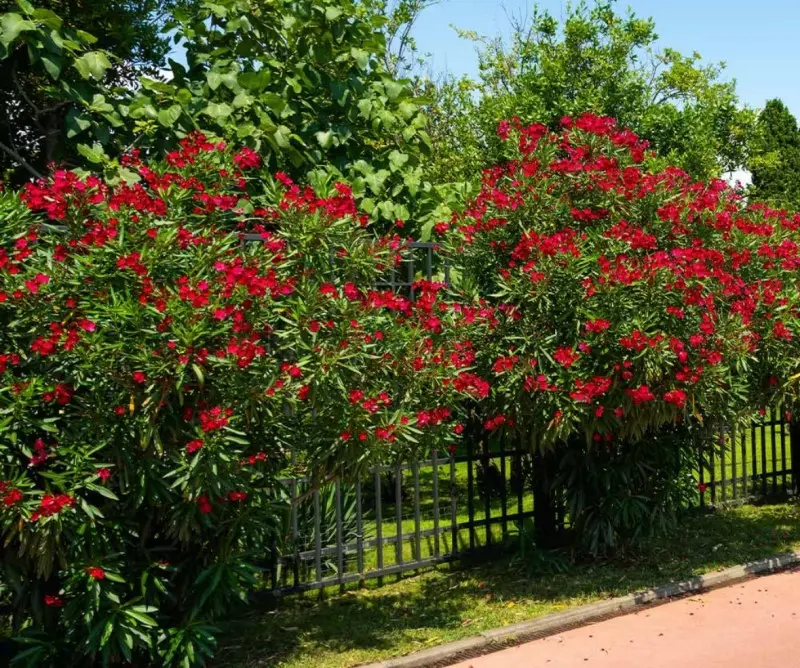
Oleander
$0.00Add to LawnFull sun-5'-15'Deer resistantOleander (Nerium oleander) is a robust, evergreen shrub or small tree renowned for its lush, dark green foliage and showy, fragrant flowers. Native to the Mediterranean and parts of Asia, Oleander produces clusters of large, trumpet-shaped flowers in vibrant shades of pink, red, white, yellow, and salmon. Blooming from late spring through fall, its long-lasting flowers add bold color to warm-climate gardens and are highly attractive to pollinators like butterflies. Oleander typically grows between 6 to 20 feet tall and 6 to 10 feet wide, depending on the variety and growing conditions. This plant thrives in full sun and is hardy in USDA zones 8-11. Known for its adaptability, Oleander tolerates a variety of soils, from sandy to loamy, as long as they are well-draining. It is also highly drought-tolerant and salt-tolerant once established, making it ideal for coastal areas, xeriscape gardens, or other low-water landscapes. Low-maintenance and easy to grow, Oleander requires occasional pruning to maintain shape and encourage new blooms, usually done in late winter or early spring. However, it’s important to handle this plant with care, as all parts of the oleander are toxic if ingested. Despite this toxicity, Oleander’s resilience, lush appearance, and profuse flowering make it a popular choice for creating colorful hedges, privacy screens, or dramatic focal points in warm-climate gardens. Its bold blooms and easy-care nature lend an exotic feel to a variety of landscape settings. -
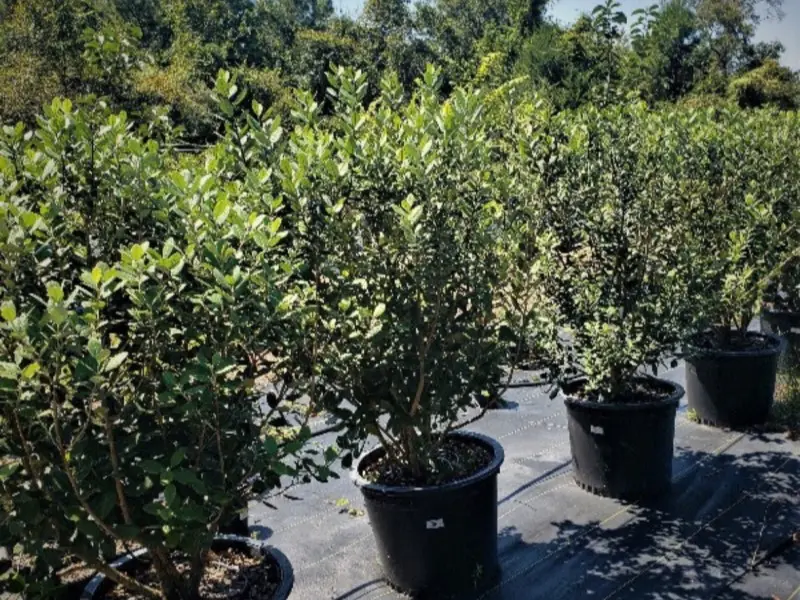
Pineapple Guava
$0.00Add to LawnFull sunPartial sun5'-10'Deer resistantPineapple Guava (Feijoa sellowiana), also known as Feijoa or Guavasteen, is an evergreen shrub or small tree known for its attractive foliage, edible flowers, and delicious fruit. Native to South America, Pineapple Guava produces unique, showy flowers in late spring to early summer, with fleshy white petals and bright red stamens. These petals are edible and have a sweet, slightly tropical flavor. In the fall, Pineapple Guava produces small, egg-shaped fruits with a sweet, aromatic flavor reminiscent of pineapple, mint, and guava. This shrub typically grows to about 10 to 15 feet in height and width, though it can be pruned to stay smaller or shaped into a hedge. Pineapple Guava thrives in full sun to partial shade and is hardy in USDA zones 8-11, with some tolerance for brief periods of frost. It prefers well-draining soil and is drought-tolerant once established, making it a great choice for xeriscaping or water-wise gardens. Low-maintenance and pest-resistant, Pineapple Guava requires little pruning beyond occasional shaping or thinning. It can also be grown in containers, making it versatile for patios or smaller spaces. The plant is self-pollinating, though planting multiple shrubs may increase fruit production. With its year-round greenery, fragrant blooms, and flavorful fruit, Pineapple Guava is a fantastic option for edible landscapes, privacy hedges, or as a standout specimen in sunny garden spots. -
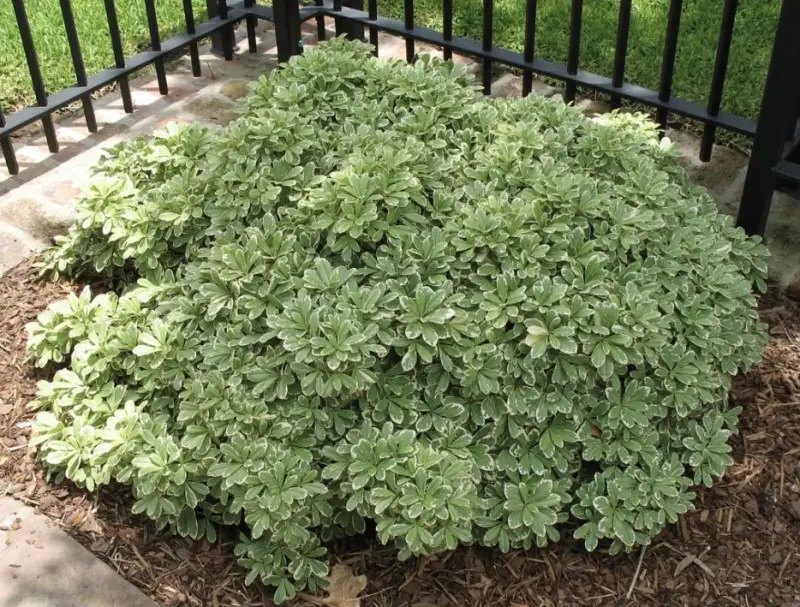
Pittosporum
$0.00Add to LawnFull sunPartial sun3'-8'Not deer resistantPittosporum (Pittosporum tobira), also known as Mock Orange or Japanese Pittosporum, is an attractive, evergreen shrub valued for its dense foliage, fragrant flowers, and versatility in the landscape. Native to Japan and China, this hardy plant features leathery, glossy, dark green leaves that grow in a rounded, compact form. In late spring, Pittosporum produces clusters of small, creamy-white, fragrant flowers that emit an orange-blossom scent, adding seasonal appeal and attracting pollinators. Pittosporum typically grows to a height of 6 to 15 feet and spreads 6 to 8 feet wide, though dwarf varieties are available that stay more compact, making it suitable for smaller gardens. This plant thrives in full sun to partial shade and is hardy in USDA zones 8-11. Pittosporum is highly adaptable to various soil types, as long as the soil is well-draining, and is moderately drought-tolerant once established, making it a popular choice for water-wise gardens. With its dense growth habit, Pittosporum is commonly used as a hedge, privacy screen, foundation planting, or specimen plant. It requires minimal pruning to maintain shape, though it can be trimmed more frequently if used as a formal hedge. Pest-resistant and low-maintenance, Pittosporum is valued for its year-round foliage, fragrant blooms, and ease of care, adding structure and elegance to both formal and informal garden designs. Its tolerance for coastal conditions also makes it a suitable choice for seaside landscapes. -
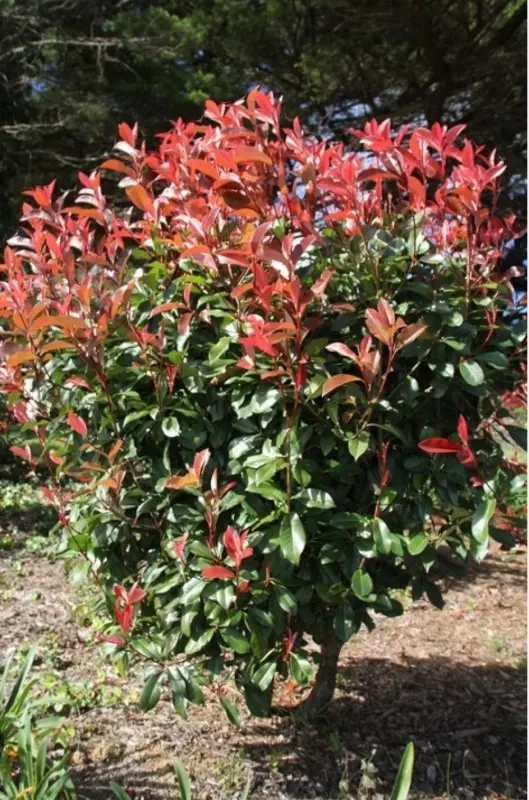
Red Tip
$0.00Add to LawnFull sunPartial sun5'-10'Not deer resistantRed Tip (Photinia x fraseri), commonly known as Fraser Photinia, is a vibrant, evergreen shrub celebrated for its striking red new foliage that matures to a glossy dark green. This color-changing characteristic makes Red Tip an eye-catching addition to landscapes, as the young, red leaves emerge in spring, providing a stunning contrast against the older green foliage. In late spring, Red Tip may produce clusters of small white flowers, which add to its seasonal interest and attract pollinators like bees. Growing to a height of 10 to 15 feet with a similar spread, Red Tip Photinia is often used as a privacy screen, hedge, or large accent shrub. It thrives in full sun to partial shade and performs best in USDA zones 7-9. This shrub is relatively adaptable to various soil types as long as they are well-draining and prefers regular watering during dry spells, although it can tolerate brief periods of drought once established. Low-maintenance overall, Red Tip may benefit from light pruning in early spring to maintain its shape and encourage the production of fresh red foliage. It’s also important to space plants adequately to promote good air circulation, as this shrub can be susceptible to leaf spot if crowded. With its year-round greenery, striking red flush, and moderate care needs, Red Tip Photinia provides a bold and colorful option for privacy hedging or as a focal point in large garden beds. -
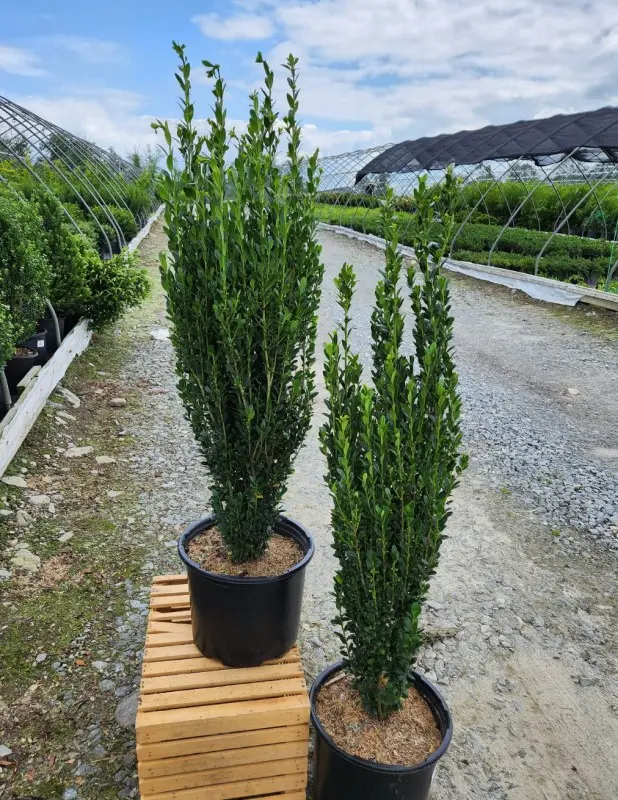
Sky Pencil Holly
$0.00Add to LawnFull sunPartial sun5'-10'Not deer resistantSky Pencil Holly (Ilex crenata ‘Sky Pencil’), also known as Japanese Holly, is a unique, narrow, columnar evergreen shrub that provides vertical interest with its slim, upright growth habit. This compact holly variety features small, dark green, glossy leaves that retain their color year-round, adding structure and elegance to gardens without taking up much space. Its naturally slender form, which reaches 6 to 10 feet tall and only about 1 to 2 feet wide, makes it ideal for tight spaces, container plantings, formal gardens, or as a vertical accent. Sky Pencil Holly thrives in full sun to partial shade and is hardy in USDA zones 5-9. It performs well in well-draining, slightly acidic soil and is moderately drought-tolerant once established. While low-maintenance, this holly can benefit from occasional pruning to maintain its desired height and shape. It is a dioecious plant, so if planted with a nearby male pollinator, female Sky Pencil Hollies may produce small black berries in fall. This holly is pest-resistant and generally untroubled by deer, adding to its appeal for low-maintenance landscapes. Sky Pencil Holly’s unique, upright shape makes it perfect for flanking doorways, lining walkways, adding height to mixed borders, or creating privacy screens. Its vertical elegance and hardiness make it a versatile and striking choice for gardeners looking to add height without width in small or formal landscapes. -
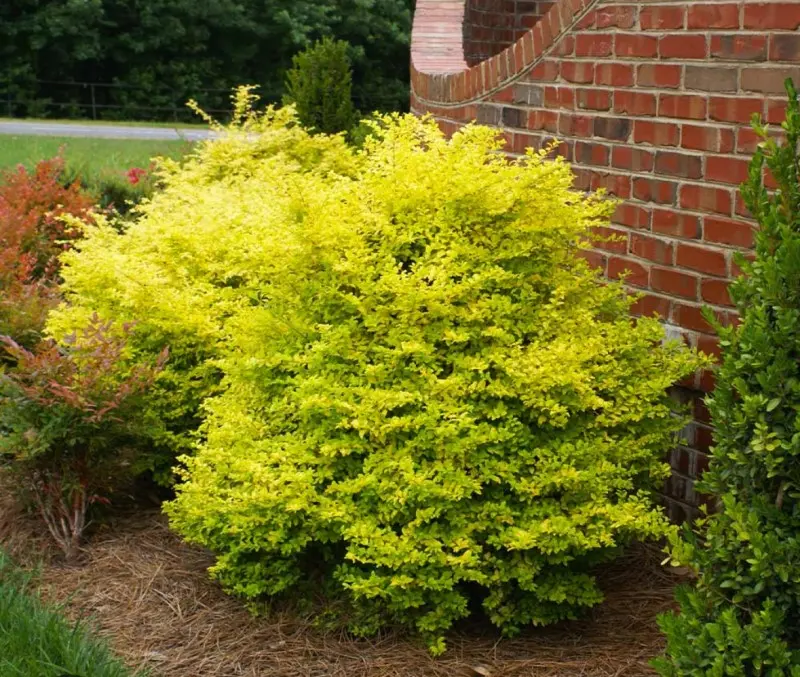
Sunshine Ligustrum
$0.00Add to LawnFull sunPartial sun3'-5'Not deer resistantThe Sunshine Ligustrum (Ligustrum sinense 'Sunshine') is an attractive, low-maintenance shrub prized for its bright golden-yellow foliage and its year-round vibrance. Unlike other ligustrum varieties, Sunshine Ligustrum is sterile, which means it does not produce blooms or seeds, making it an ideal option for those who prefer a non-invasive, low-pollen landscape addition. Its dense, compact growth habit reaches about 3 to 6 feet in height and width, and it can be easily pruned for shape or to fit specific landscape designs, whether as a hedge, accent, or container plant. This plant thrives in full sun, where it develops its brightest color, and tolerates a range of soil types, from clay to sandy soils, as long as they are well-draining. Sunshine Ligustrum is also drought-resistant and has moderate salt tolerance, making it suitable for coastal or arid environments. It is generally hardy in USDA zones 6-10 and can withstand winter temperatures down to about 0°F. Sunshine Ligustrum also tolerates urban pollution, making it a resilient choice for city gardens or suburban landscapes. Perfect for brightening landscapes, the Sunshine Ligustrum provides vivid contrast against darker foliage and pairs well with other evergreens, flowering shrubs, or perennials. Its resistance to common pests and diseases also contributes to its popularity in low-maintenance landscape designs. -
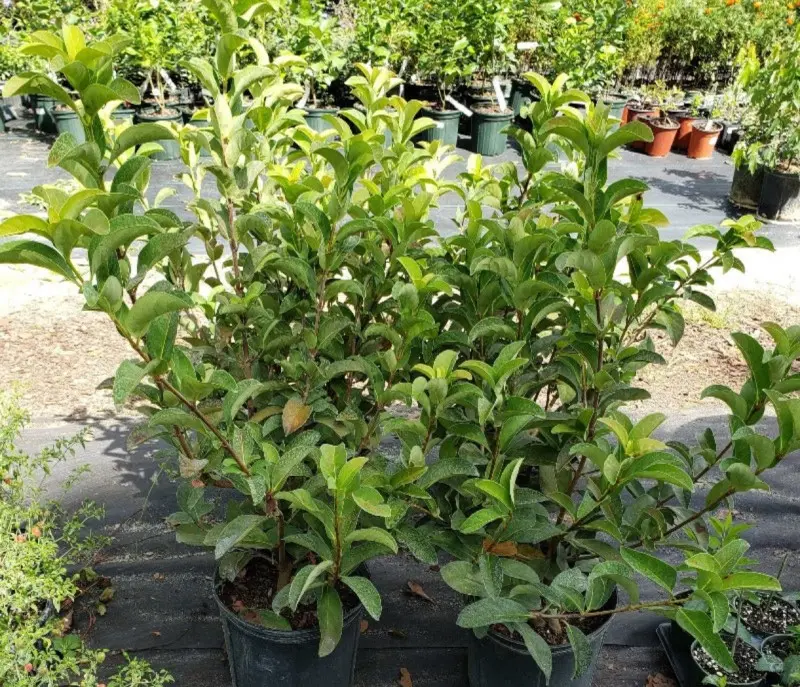
Sweet Viburnum
$0.00Add to LawnFull sun-6'-15'Deer resistantSweet Viburnum (Viburnum odoratissimum) is an evergreen shrub or small tree valued for its glossy green foliage, fragrant white flowers, and versatility in the landscape. Native to Asia, this hardy plant produces clusters of small, sweetly scented white flowers in spring, which are highly attractive to pollinators. The blooms are followed by small red berries that mature to black, providing additional interest and food for birds in fall. Sweet Viburnum can grow to impressive heights, typically reaching 10 to 20 feet tall and wide, though it can be maintained at a smaller size with regular pruning. Its dense growth habit makes it a popular choice for hedges, privacy screens, or windbreaks. This plant thrives in full sun to partial shade and is hardy in USDA zones 8-10. It prefers well-draining soil and is relatively drought-tolerant once established, though it benefits from occasional watering in dry periods. Known for its pest and disease resistance, Sweet Viburnum is generally low-maintenance, requiring only occasional pruning to maintain its shape and encourage bushier growth. With its lush foliage, fragrant flowers, and ability to grow into a dense screen, Sweet Viburnum is a versatile choice for creating privacy, adding greenery, or enhancing garden structure with a touch of elegance. Its adaptability and ease of care make it a favorite for both formal and natural landscapes. -

Texas Sage
$0.00Add to LawnFull sun-3'-8'Deer resistantTexas Sage (Leucophyllum frutescens), also known as Cenizo, Texas Ranger, or Silverleaf, is a hardy, drought-tolerant shrub prized for its silvery-gray foliage and vibrant blooms. Native to the southwestern United States and northern Mexico, Texas Sage produces beautiful purple, lavender, or magenta flowers after periods of rain or humidity, often creating a stunning display in the late summer and fall. The blooms are tubular, attracting pollinators like bees and butterflies, and contrast strikingly with the plant’s soft, silvery leaves. This shrub typically grows 3 to 6 feet tall and wide, though it can reach up to 8 feet in ideal conditions. Texas Sage thrives in USDA zones 8-11 and prefers full sun, where it will produce the most prolific blooms and dense foliage. It is highly adaptable to various soil types, including rocky, sandy, or alkaline soils, as long as they are well-draining. Texas Sage is also highly heat- and drought-tolerant once established, making it perfect for xeriscaping and low-water landscapes. Requiring minimal maintenance, Texas Sage can be lightly pruned to shape, especially in spring, but it generally maintains a neat, rounded form. It is resistant to pests and diseases, adding to its popularity as a low-maintenance choice for landscapes. Texas Sage is commonly used as a hedge, border, or specimen plant, adding both color and texture to desert, southwestern, or coastal garden designs. With its resilience, stunning flowers, and silvery foliage, Texas Sage is an iconic and attractive choice for hot, dry climates.

